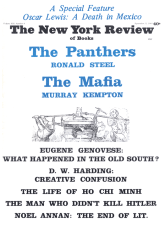In response to:
What Is Quality in Music? from the June 19, 1969 issue
To the Editors:
Virgil Thomson knows everything there is to know about music; he writes prose that is clear and engaging; he also knows a great deal about literature—both English and French. In fact, Mr. Thomson is one of the most brilliant and cogent people I’ve ever met. But he does not “dig” painting and sculpture—not as deeply as he might since he does not fully comprehend that these arts become commodities, and when the “quality” is high—such commodities command an ever-expanding market.
Mr. Thomson suggests (in the June 19th issue) “When shopping for a picture be sure to take a painter.”
Mr. Thomson does not tell which painter or which kind of painter. Had he, twenty years ago, gone shopping with Picasso he would have ended up with a Dominguez, not a Matisse. Had he gone shopping with Edward Hopper he might have gotten a Eugene Speicher. Had he gone shopping with Grant Wood he would have returned with a Joe Jones. And so.
Let the prospective buyer go to a good dealer and he will find himself with splendid works of art. Surely Mr. Thomson has not forgotten how lucky those people were who went to Vollard, or Kahnweiler, or Rosenberg, or even Lord Duveen—and truly wanted to purchase something splendid—how well they were served?
John Bernard Myers
New York City
Virgil Thomson replies:
In answer to the warmly indignant letter of Frank Kofsky:
European I cannot claim to be, having been born in Kansas City, Missouri in 1896 and spent my first twenty-and-more years there.
Those years in that place were vigorous ones for blues and jazz. And though my growing-up in the midst of these does not make me an authority, neither does it disqualify me from discussing them.
As for the word anonymous, can we not stipulate that in standard usage this means unsigned rather than unidentifiable?
In using production procedure I had hoped to avoid by the neutral term any implication that this music is formally composed, written out beforehand. Neither, of course, is it wholly improvised. Actually it is produced with some planning and some spontaneity, but for the most part without a manuscript; and therefore both in public execution and in recording large areas of it do remain uncredited.
Regarding art purchases and salesmanship:
I find nothing wrong in the choices of picture-buys that Mr. Myers imagines certain painters might have suggested twenty years ago, excepting for the outlandish price differences, even then, between a Matisse (however small) and a Dominguez (however large). I cannot see Picasso giving advice without noting the disproportion in costs—say 100 to 1.
Where I differ seriously with Mr. Myers, and where I think any of the painters mentioned would have differed is in assuming the name-size-price-and-merchant aspect of art to be a gauge of quality. Certainly I should have trusted Picasso or Hopper (I never knew Grant Wood) as judges of artistic excellence, paint quality, and long-term investment over any dealer offering artifacts for sale.
Who are you trying to kid, John? Do you really consider a workman’s judgment valueless and a salesman the source of all wisdom? I would take a small bet that if you yourself were buying a Matisse you believed to be major (and I said buying, not selling), you would be grateful to know what Picasso frankly thought of it as a Matisse.
Note: Mr. Thomson has asked us to make it clear that his essay will appear in Quality, to be published by Atheneum, a fact which we omitted through no fault of Mr. Thomson.
This Issue
September 11, 1969



